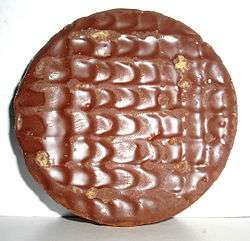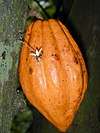Chocolate biscuit
 A chocolate-covered digestive biscuit | |
| Type | Biscuit |
|---|---|
| Main ingredients | Flour, cocoa powder or chocolate |
A chocolate biscuit is a biscuit which is covered in chocolate, or which has been made by replacing some of the flour with cocoa powder.
Chocolate biscuits are quite popular in places all over the world.[1] The composition and recipe may vary considerably and there is often legislation to specify how the biscuit may be described. In the UK, a biscuit made without an external coating may only be described as "chocolate" if it contains at least 3% of dry cocoa solids.[2] If there is a coating, this must contain cocoa butter as the fat to be described as chocolate, rather than just "chocolate-flavoured".[1]
Tax
The exact structure and composition is significant in determining the taxation applicable in the UK as valued-added tax (VAT). The general principle is that luxury foods such as confectionery are taxable, while basic foodstuffs are not. Case law and rulings have determined that a chocolate-covered biscuit such as a chocolate digestive or Kit Kat is taxable while a chocolate-chip cookie or Jaffa cake is not.[3][4]
References
- 1 2 Duncan Manley (1998), Biscuit, Cookie and Cracker Manufacturing Manuals, 5. Secondary Processing in Biscuit Manufacturing, Elsevier, p. 22, ISBN 9781855736245
- ↑ P. R. Whitely (2012), Biscuit Manufacture: fundamentals of in-line production, Springer Science & Business, p. 79, ISBN 9781461520375
- ↑ "The bounds of confectionery, sweets, chocolates, chocolate biscuits, cakes and biscuits: Chocolate biscuits", VFOOD6240 - Food: Excepted items: Confectionery, Her Majesty's Revenue & Customs
- ↑ John Connell (9 August 2012), "Bitter-sweet rules on chocolate very taxing for Cumbrian shoppers", News & Star
